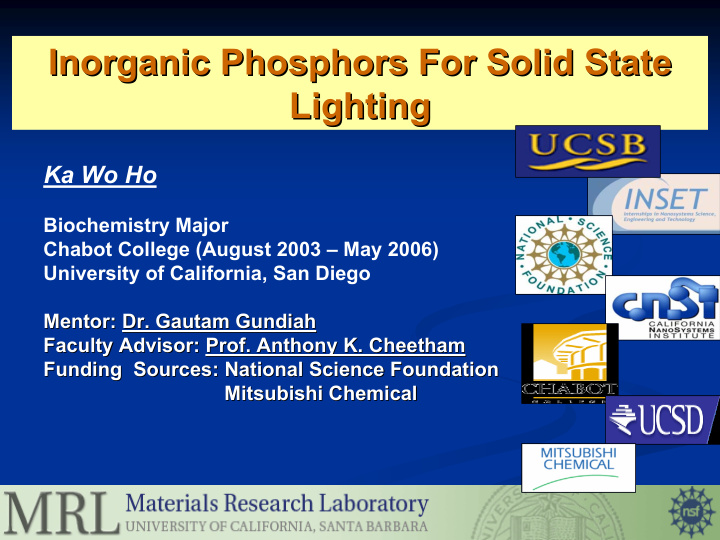



Inorganic Phosphors For Solid State Inorganic Phosphors For Solid State Lighting Lighting Ka Wo Ho Biochemistry Major Chabot College (August 2003 – May 2006) University of California, San Diego Mentor: Dr. Dr. Gautam Gautam Gundiah Gundiah Mentor: Faculty Advisor: Prof. Anthony K. Prof. Anthony K. Cheetham Cheetham Faculty Advisor: Funding Sources: National Science Foundation Funding Sources: National Science Foundation Mitsubishi Chemical Mitsubishi Chemical
Introduction Introduction Light emitting diode (LED) based lighting- - efficient for white light. efficient for white light. Light emitting diode (LED) based lighting � � High luminous efficacy without consuming large amount of energy. High luminous efficacy without consuming large amount of energy. � � White light is composed of blue, green and red colors. White light is composed of blue, green and red colors. � � http://www.answers.com Strategies to obtain white light Unavailable Nowadays Available Nowadays Green Phosphor Blue LED Yellow Phosphor White Light Blue LED Red Phosphor White Light ????? Y 3 Al 5 O 12 : Ce yttrium aluminium aluminium garnet (YAG) garnet (YAG) yttrium Goals Investigate new red phosphor that could be excited using the blue LED e LED- - Investigate new red phosphor that could be excited using the blu � � Y 3 Al 5 O 12 :Ce+Cr Y 3 Al 5 O 12 :Ce+Cr
Experimental Procedure for YAG Solid state route: Mix compounds homogenously by grinding. Pelletize Tube Pellet Gas Gas Furnace Heating Grinding UV Lamp Impure Samples Powder Diffractometer Samples Pure Samples X-Ray Diffraction --- Check the purity of the samples . Photoluminescence Measurement Photoluminescence --- Check the emission of radiation from Spectrometer excitation by using specific wavelength. Pelletizer Photoluminescence Spectrometer Powder Diffractometer Mortar & Pestle Tube Furnace
Experimental Data Powder X-Ray Diffraction Y 3 Al 5 O 12 : Ce(2%), Cr(2%)- heated at 1500 o C for 2 hours. h o 4 (2 ) Intensity 1 0 0 0 0 0 5 0 0 0 0 0 2 theta 2 0 3 0 4 0 5 0 6 0 7 0 •The above matched the standard X-ray diffraction pattern of cubic-Y 3 Al 5 O 12 . Optimal heating temperature was 1500 o C for all reactions. • Impurities of starting materials present when heating temperature was low.
Photoluminescence Measurements Schematic Int. Emission (1 ) YAG : Ce Int. Emission Blue LED Ce Amount of Ce Amount of Cr (2) YAG: Ce, Cr Blue LED No emission Ce Ce Ce Ce Ce Cr Cr Cr Cr The concentration of the Ce increased that caused quenching of the luminescence.
Graphs for Photoluminescence Measurement Luminescence of YAG doped with Ce Y 3 Al 5 O 12 :Ce λ em =540nm 1000 λ ex =460nm 800 • Optimal excitation of Ce at 460nm • Emission centered at 540nm Intensity (au) 600 • Matches with standard spectrum 400 200 0 400 450 500 550 600 650 700 Wavelength (nm)
Luminescence studies on YAG doped with different amounts of Ce and Cr 70 Cr emission λ ex = 460nm • Ce absorbs blue excitation 60 and transfers part to Cr Intensity (au) 50 • Ce % ↑ , yellow emission ↓ 40 Intensity (au) • Cr % ↑ , red emission ↑ (upto 30 660 680 700 720 740 10% Cr ) Wavelength (nm) • When Ce>20%, no pure 20 Ce, Cr phase obtained. 10 20%, 5% • When Cr=10%, quenching 10%, 2% Observed. 2%, 2% 0 450 500 550 600 650 700 750 800 Wavelength (nm)
Summary • Synthesized pure samples of YAG:Ce+Cr • Determined that energy transfer occurs between Ce and Cr • Reduced the Ce emission (540nm) by luminescence quenching • Increased Cr emission (700nm) Further work… • Improve the efficiency of energy transfer (intensity of Cr peak) by attempting synthesis of Gd 3 Al 5 O 12 :Ce+Cr • Look for green phosphor that could be excited by blue LED
Acknowledgements Material Research Laboratory, UCSB Material Research Laboratory, UCSB Mentor : Mentor : Gautam Gautam Gundiah Gundiah Faculty Advisor : Prof. A. K. Faculty Advisor : Prof. A. K. Cheetham Cheetham INSET : Samantha Freeman, Liu-Yen Kramer, Nick Arnold, Andrew Morrill CNSI : Prof. Evelyn Hu Cheetham Group : Eduardo Falcao, Kinson Kam, Crystal Merrill, Russell Feller, Katherine Page, Zeric Hulvey, Ethan Sullivan Joe Doyle Seshadri Group members, Norman Hoffmann INSET interns
Question ???? Thank You for your kind attention! Thank You for your kind attention!
What is LED? Definition http://www.treehugger.com •GaN-based diodes emit bright violet-blue light, which can be used to pump longer wavelength phosphors to obtain white light emitting diodes(LEDs). • Blue LED is a GaN-based light emitting diodes. • Developed by Prof. Shuji Nakamura who works in UCSB now.
Application for Blue LEDs? • Traffic light • Medical instruments. • Displays • Headlight of cars • TV displays Advantages for using Blue LEDs? • Absolutely save more energy than compact fluorescent lamp, incandescent lamp and high-pressure sodium lamp. • Save energy, Save money! • Good color rendering for object.
Materials for YAG (1)Y 3 Al 5 O 12 Y 2 O 3 +Al 2 O 3 (2) Y 3 Al 5 O 12 : Ce Y 2 O 3 +Al 2 O 3 +CeO 2 (3) Y 3 Al 5 O 12 : Ce, Cr Y 2 O 3 +Al 2 O 3 +CeO 2 +Cr 2 O 3
460nm for Blue LED
Crystal-field splitting for Ce 3+
Recommend
More recommend